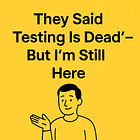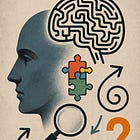How Testers Should Use AI (Without Looking Foolish)
AI has crashed into our world of testing like a storm. Every week there’s a new “AI agent” or “copilot” promising speed, scalability, and even the death of testers. But here’s the uncomfortable truth: if we don’t use AI wisely, we risk making ourselves look foolish, lazy, or worse, replaceable.
At the recent Testμ Conference by LambdaTest on “What Can Go Wrong with AI”, I listened to some of the sharpest minds in testing: James Bach, Michael Bolton, Seema Prabhu, Benjamin Bischoff, and Brijesh Deb. They ripped apart the hype and shared both the dangers and the opportunities. Their words hit hard, and I couldn’t help but connect them back to how testers should actually approach AI.
Let me walk you through the highlights and what we testers should take away.
Quick pause: if you’re finding this interesting already, hit subscribe to LifeOfQA so you don’t miss future posts like this.
1. Reputation is Fragile
James opened with a hard truth:
“As soon as somebody knows that you use AI, they may assume the AI did all the work, not you.”
That stings. Imagine putting out solid work, only for people to dismiss it as “oh, AI did that.” If we lean too heavily on AI, we risk eroding the very reputation we’ve built through skill and judgment.
Takeaway for testers: Use AI as support, not as your replacement. Always leave your fingerprint of thinking.
2. Don’t Outsource Your Brain
Ben warned of “cognitive offloading.” The more we let AI think for us, the more we stop thinking at all.
That’s how critical thinking dies, not with a bang, but with endless prompts.
Takeaway for testers: Let AI spark ideas, but challenge them. Don’t accept the first shiny answer just because it looks convincing.
3. The Trust Collapse
Michael took it a step deeper:
“AI isn’t just eroding trust in tools. It’s eroding trust in everything.”
When LLMs spit out hallucinations, fake references, or confidently wrong answers, the danger isn’t just bad output. It’s the slow erosion of trust: in data, in reports, even in each other.
Takeaway for testers: Treat AI like an unreliable narrator. Always verify before acting.
4. The Productivity Paradox
This one hit me hard. James called it the productivity paradox of AI:
AI can produce results in seconds.
But to check them properly takes hours.
If you skip checking, you’re reckless.
If you do check, you might as well have done it yourself.
Sound familiar? I’ve been there. AI cleans up code but adds fake functions. Or it generates tests, but misses the critical ones. Faster doesn’t always mean better.
Takeaway for testers: Use AI for small, checkable tasks (like James’s logging experiment), not entire frameworks. Otherwise, you’ll lose more time than you gain.
5. Bias: The Ugly Mirror
Seema reminded us that bias in AI isn’t some alien invention. It’s our own reflection. Racist datasets, skewed patterns, over-represented “popular” cases… AI mirrors our ugliness back at us.
When testers rely on biased AI outputs (for test data, visual validation, triage), we risk baking exclusion into the product.
Takeaway for testers: Always question the dataset. Test for the invisible users, the ones AI might forget.
6. The “Worst-Case” Scenario
The scariest moment came when James shared what he’s seen in real companies:
CTOs firing testers because they think “AI will do all the testing now.”
This isn’t hypothetical. It’s happening. And it’s a bigger risk than any single bug. Because once management starts believing AI equals testing, human oversight gets pushed out of the picture.
Takeaway for testers: Never let your role be reduced to “AI prompt operator.” Our value is judgment, context, and human accountability.
7. Where AI Actually Helps
Okay, enough doom. The panel also shared some genuine positives:
Safety nets: James uses AI to pull out “testable elements” from user stories. Not as final tests, but as a safety net to spot what he might have missed.
Rubber ducking: Ben treats AI as a “more sophisticated rubber duck,” a sparring partner for ideas.
Mirrors: Michael sees AI as a mirror that reflects our bad habits in coding, security, and design.
Takeaway for testers: AI shines when used as a thinking aid, not as an execution engine.
8. Final Advice from the Panel
Each panelist left testers with one piece of advice:
Ben: Learn AI. Use it. Stay skeptical.
Michael: Never treat a pleasing demo as proof of reliability.
Seema: Get your fundamentals right and reimagine your role.
Brijesh: Never discount the human. Verify everything.
Or in simpler words: Trust after you verify.
Closing Thoughts
Walking out of that discussion, one phrase kept ringing in my head:
👉 Don’t use AI in a way that makes you look foolish.
Don’t brag about “AI wrote all my tests.”
Don’t ship code you don’t understand.
Don’t let AI erode your reputation or your curiosity.
Use AI like a hunting dog. Let it sniff around, point you to things you might have missed. But remember, you’re the hunter. You pull the trigger.
That’s how testers should use AI: with brains fully engaged, reputation intact, and foolishness kept far away.
Final Words
Testing has always been about human judgment in the face of complexity. AI doesn’t change that. It only makes our role more important. So, let’s experiment boldly, critique relentlessly, and never forget:
AI may generate, but we evaluate.
Further Reading
If you found this useful, you might also enjoy these articles:
Bonus: Things I Remind Myself When Using GenAI
Panel insights are great, but here’s my own checklist I use when working with AI:
State the intent – task, audience, constraints, format, length.
Fence the scope – domain, region, timeframe, exclusions.
Demand a rubric – ask the model how it will judge its own output.
Probe for error – ask “what might be wrong or missing?”
Seek evidence – request references or examples.
Compare variants – merge 2–3 different answers.
Keep a test set – good examples to re-check outputs over time.
👉 Quick rule: Trust drafts, verify data, and never outsource your brain.
If you found this helpful, stay connected with Life of QA for more real-world testing experiences, tips, and lessons from the journey!





Well said. I wrote an article recently as well.